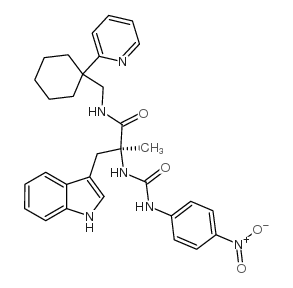204066-82-0
| Name | PD 168368,(S)-α-Methyl-α-[[[(4-nitrophenyl)amino]carbonyl]amino]-N-[[1-(2-pyridinyl)cyclohexyl]methyl]-1H-indole-3-propanamide |
|---|
| Description | PD 168368 is a potent, competitive, and selective neuromedin B receptor (NMB-R) antagonist with the Ki of 15–45 nM[1]. PD 168368 is neuromedin B receptor (NMBR; IC50=96 nM) / gastrin-releasing peptide receptor (GRPR IC50=3500 nM) antagonist[2]. PD 168368 also is a mixed FPR1/FPR2/FPR3 agonist with EC50s of 0.57, 0.24, and 2.7 nM, respectively[3]. |
|---|---|
| Related Catalog | |
| In Vitro | PD 168368 (PD168368) is highly active and stimulated [Ca2+]I release in human neutrophils with EC50 values in the nanomolar range[3]. PD 168368 (PD168368) suppresses migration and invasion of the human breast cancer cell line MDA-MB-231. PD 168368 reduces epithelial-mesenchymal transition (EMT) of breast cancer cells by E-cadherin upregulation and vimentin downregulation. PD 168368 (5 μM) inhibits migration and invasiveness in breast cancer cells[4]. PD 168368 (10 μM) suppresses the activation of mTOR/p70S6K/4EBP1 and AKT/GSK-3β pathways in breast cancer cells[4]. Cell Viability Assay[4] Cell Line: Human breast cancer cell line MDA-MB-231 Concentration: 5 μM Incubation Time: 24 hours Result: Clearly decreased the migratory ability of MDA-MB-231 cells in a Boyden chamber migration assay. Cell Viability Assay[4] Cell Line: MDA-MB-231 cells Concentration: 10 μM Incubation Time: 0, 0.5, 1, 2, 4, 8, and 16 hours Result: Decreased phosphorylation levels of mTOR, p70S6K, 4EBP1, AKT and GSK-3β in a time-dependent manner. |
| In Vivo | PD 168368 (PD168368) potently inhibits in vivo metastasis of breast cancer. PD 168368 (1.2 mg/kg; intraperitoneal injection for 30 days) inhibits metastasis of breast cancer in mice[4]. Animal Model: Female BALB/c-nude mice (age 8-10 weeks) bearing MDA-MB-231 xenograft model[4] Dosage: 1.2 mg/kg Administration: Intraperitoneal injection for 30 days Result: No metastatic tumor nodules were observed in lungs of PD 168368-treated mice compared to PEG-injected mice. |
| References |
| Molecular Formula | C31H34N6O4 |
|---|---|
| Molecular Weight | 554.63900 |
| Exact Mass | 554.26400 |
| PSA | 144.73000 |
| LogP | 6.99030 |
